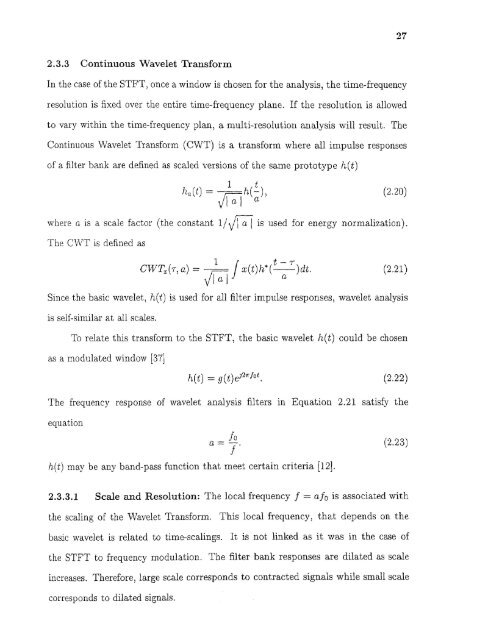Space/time/frequency methods in adaptive radar - New Jersey ...
Space/time/frequency methods in adaptive radar - New Jersey ...
Space/time/frequency methods in adaptive radar - New Jersey ...
You also want an ePaper? Increase the reach of your titles
YUMPU automatically turns print PDFs into web optimized ePapers that Google loves.
272.3.3 Cont<strong>in</strong>uous Wavelet TransformIn the case of the STFT, once a w<strong>in</strong>dow is chosen for the analysis, the <strong>time</strong>-<strong>frequency</strong>resolution is fixed over the entire <strong>time</strong>-<strong>frequency</strong> plane. If the resolution is allowedto vary with<strong>in</strong> the <strong>time</strong>-<strong>frequency</strong> plan, a multi-resolution analysis will result. TheCont<strong>in</strong>uous Wavelet Transform (CWT) is a transform where all impulse responsesof a filter bank are def<strong>in</strong>ed as scaled versions of the same prototype h(t)where a is a scale factor (the constantis used for energy normalization).The CWT is def<strong>in</strong>ed asS<strong>in</strong>ce the basic wavelet, h(t) is used for all filter impulse responses, wavelet analysisis self-similar at all scales.To relate this transform to the STFT, the basic wavelet h(t) could be chosenas a modulated w<strong>in</strong>dow [37]The <strong>frequency</strong> response of wavelet analysis filters <strong>in</strong> Equation 2.21 satisfy theequationh(t) may be any band-pass function that meet certa<strong>in</strong> criteria [12].2.3.3.1 Scale and Resolution: The local <strong>frequency</strong> f aƒ 0 is associated withthe scal<strong>in</strong>g of the Wavelet Transform. This local <strong>frequency</strong>, that depends on thebasic wavelet is related to <strong>time</strong>-scal<strong>in</strong>gs. It is not l<strong>in</strong>ked as it was <strong>in</strong> the case ofthe STFT to <strong>frequency</strong> modulation. The filter bank responses are dilated as scale<strong>in</strong>creases. Therefore, large scale corresponds to contracted signals while small scalecorresponds to dilated signals.
















